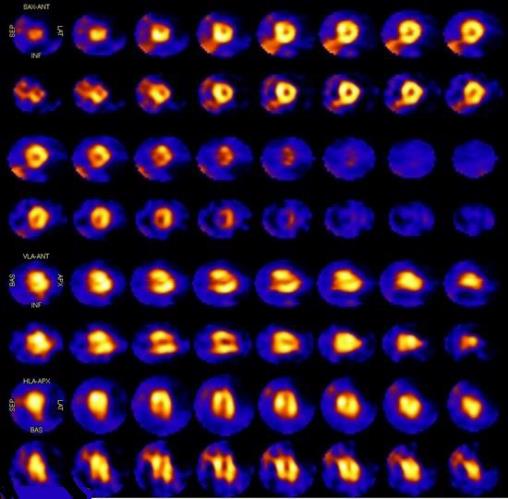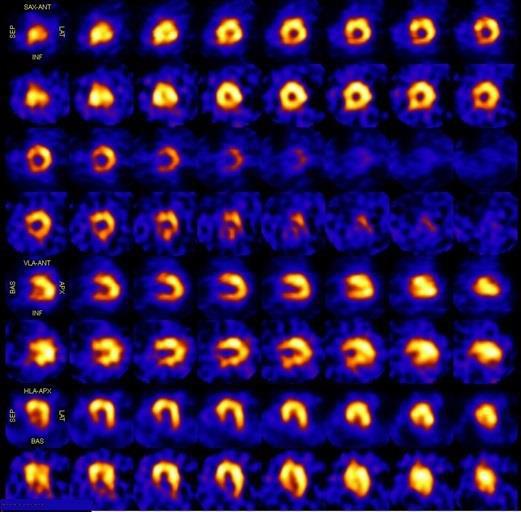Rafla S. Cardiol Cardiovasc Med. 2020;4(1):45-57.
Ischemic heart disease (IHD) is influencing many parts of the world and becoming a major health issue. Chest pain is the second most common cause of non-injury associated emergency department visits. A multitude of analytical tools are present for the estimation of chest pain. Radionuclide myocardial perfusion imaging is a well-established non-invasive imaging technique that yields both diagnostic and prognostic data. Intravenous radiopharmaceuticals classifies to the myocardium with proportion to regional myocardial perfusion in radionuclide myocardial perfusion imaging to evaluate myocardial perfusion in stress and rest. Exercise stress is the most physiological form of cardiac stress hence, is preferred over pharmacologic agents, it enables the evaluation of exercise capacity, heart rate and blood pressure responses comprising reserve and recovery, and the evolution of symptoms that are beneficial for clinical decision making. Pharmacologic stress is used for patients unable to exercise or achieve a sufficient level of exercise. Thus, Rafla S et al., conducted a study to analyse the occurrence and extremity of chest pain in radionuclide myocardial perfusion imaging and its association to the findings of the radionuclide myocardial perfusion imaging (MPI) and stress modality used.
100 patients were included in the retrospective and prospective study; all the 100 patients had positive Thallium result i.e. showed perfusion defects. Patients were divided into two groups that presented for radionuclide myocardial perfusion imaging. The first group included 50 patients exposed to exercise stress testing. The second group included 50 patients exposed to dipyridamole pharmacologic stress testing. The chest pain, dyspnea, electrocardiographic changes, left ventricular dilatation, and increased lung thallium uptake were compared between 2 groups.
Exercise showed a statistically substantial greater occurrence and extremity of chest pain as compared to dipyridamole (p<0.001). The occurrence and extremity of chest pain were associated to the number of vessel territories influenced in the dipyridamole group (p=0.037), however not in the exercise group. Exercise showed a statistically substantial greater occurrence of electrocardiographic (ECG) changes as compared to dipyridamole (p<0.001). Nevertheless, there was no statistically substantial difference in the occurrence of left ventricular (LV) dilatation and of elevated lung thallium-201 uptake among the 2 groups. The occurrence of left ventricular dilatation was correlated with the number of vessel territories influenced in the exercise group (p=0.011) as well as the dipyridamole group (p=0.007). The occurrence of enhanced lung thallium-201 uptake was associated with the number of vessel territories influenced in the exercise group (p=0.017) but not in the dipyridamole group. Four parameters i.e. 1- chest pain (one or two or three points), 2- ECG changes > 1mm (two points), 3- LV dilation (two points), and 4- Lung thallium uptake (two points) were summed, so maximum can be 9 points for each patient. The results were compared in every patient with the degree of perfusion defects (meaning number of vessels affected). Association showed substantial relation (p<0.05) hence new score of validation was postulated of positivity of perfusion defects, the greater the score of these parameters, the greater the expected percent of perfusion defect verifies the positivity of ischemia. Thallium perfusion could be estimated through this new way.
Thus, it was concluded that exercise stress and vasodilator pharmacologic stress act through different techniques despite having the same end result of accomplishing heterogeneous perfusion among normal vessels segments and diseased vessels segments. Myocardial ischemia is the cause of chest pain and ECG changes in SPECT and MPI and new score of adding 4 parameters together was associated with the extremity of perfusion defects.

Figure 1: A 60 years old male patient presented to Alexandria university nuclear cardiology lab for assessment of class II chest pain. The patient was diabetic and had history of ischemic heart disease. The test result showed ischemia in the LAD artery and the RCA territories, both left and right ventricle dilatation during rest that increased during stress, and no increased lung thallium-201 uptake. Clinical score 2+2. Thallium score 2+2

Figure 2: A 61 years old male patient presented to Alexandria university nuclear cardiology lab for assessment of class III chest pain and dyspnea. The patient was smoker and hypertensive. The test result showed ischemia in the LAD artery, the RCA, and the LCX artery territories, left ventricle dilatation during stress, and no increased lung thallium-201 uptake. Clinical score 3+2+2; thallium score 2+2+2.
LAD: Left anterior descending; RCA: Right coronary artery; LCX: Left circumflex; SPECT: Single photon emission computed tomography

